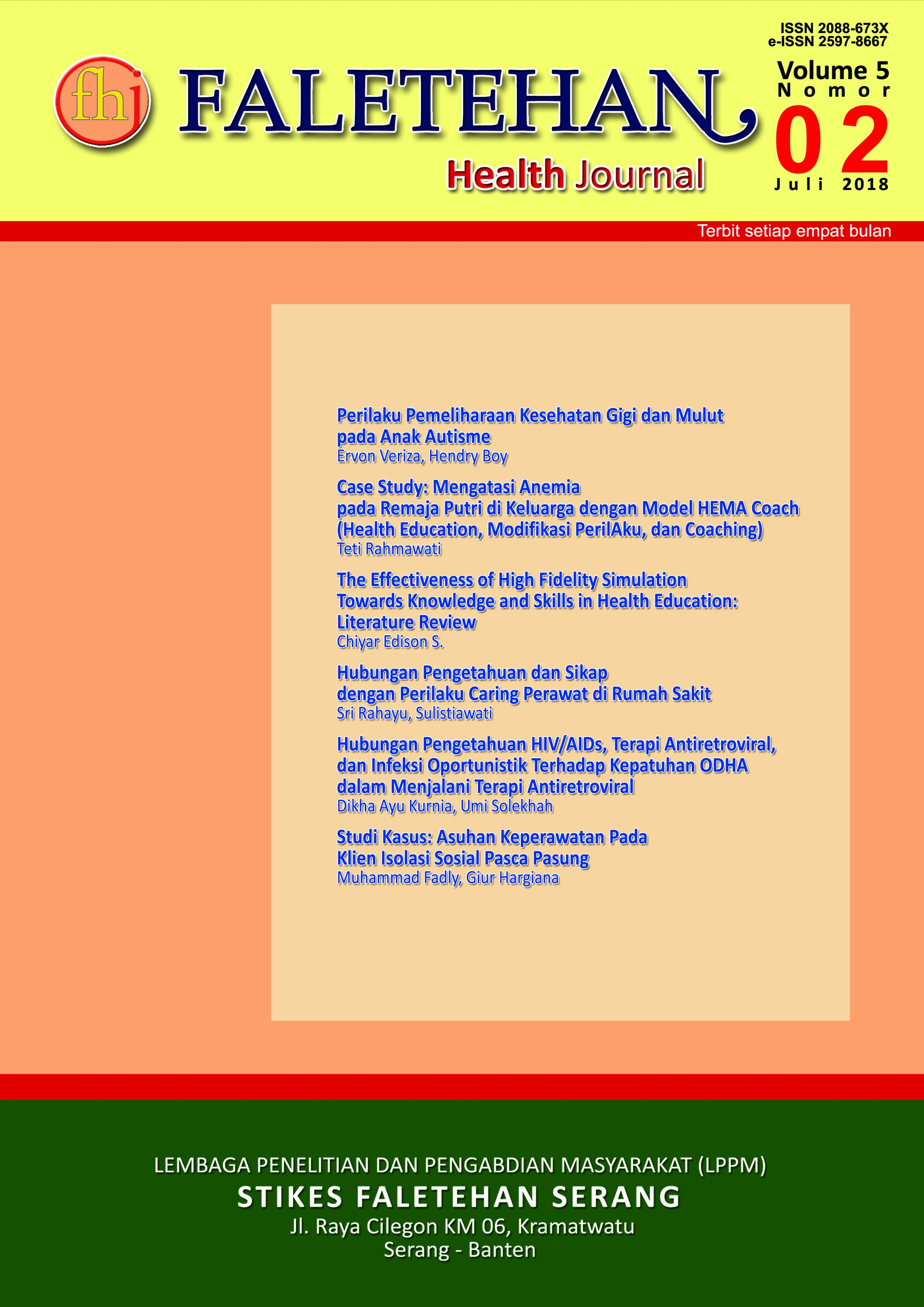The Effectiveness of High Fidelity Simulation Towards Knowledge and Skills in Health Education
Literature Review
DOI:
https://doi.org/10.33746/fhj.v5i2.11Keywords:
High Fidelity Simulation, knowledge, skillAbstract
High Fidelity Simulation (HFS) has been recently deemed an effective approach to resemble the real clinical situation so that the improvement of knowledge and skill of student are much more significant. However, there has been much debate in recent times whether this method is much more effective than conventional simulation. This literature review aimed to present the evidence supporting of the effectiveness of HFS especially in enhancing knowledge and skill of health care student. Search terms including “high fidelity simulation”, “knowledge” and “skill” were processed into CINAHL, PubMed and Bristish Nursing Index. All papers that published after 2005 and primary research were included. There were totally 9 papers included in this review, as a result of back chaining method involved in searching strategy. This review suggests that HFS is able to improve skill and knowledge of student effectively.
Downloads
References
Campbell, D. M. et al. (2009). High Fidelity Simulation In Neonatal Resuscitation. Pediatric Child Health, 14, pp. 19-23.
Cherry, R. A., Williams, J., George, J., & Ali, J. (2007). The effectiveness of a human patient simulator in the ATLS shock skills station. Journal of Surgical Research, 139(2), 229-235.
Crofts, J. F., Bartlett, C., Ellis, D., Hunt, L. P., Fox, R., & Draycott, T. J. (2006). Training for shoulder dystocia: a trial of simulation using low-fidelity and high-fidelity mannequins. Obstetrics & Gynecology, 108(6), 1477-1485.
Decker, S., Sportsman, S., Puetz, L., & Billings, L. (2008). The evolution of simulation and its contribution to competency. The Journal of Continuing Education in Nursing, 39(2), 74-80..
Gaba, D. M. (2004). The future vision of simulation in health care. BMJ Quality & Safety, 13(suppl 1), i2-i10
Gordon, C. J., & Buckley, T. (2009). The effect of high-fidelity simulation training on medical-surgical graduate nurses’ perceived ability to respond to patient clinical emergencies. The Journal of Continuing Education in Nursing, 40(11), 491-498.
Hanberg, A., Brown, S. C., Hoadley, T., Smith, S., & Courtney, B. (2007). Finding funding: The nurses' guide to simulation success. Clinical Simulation in Nursing, 3(1), e5-e9.
Hoffmann, R. L., O'donnell, J. M., & Kim, Y. (2007). The effects of human patient simulators on basic knowledge in critical care nursing with undergraduate senior baccalaureate nursing students. Simulation in Healthcare, 2(2), 110-114.
Howard, V. M. (2007). A comparison of educational strategies for the acquisition of medical-surgical nursing knowledge and critical thinking skills: Human patient simulator vs. the interactive case study approach (Doctoral dissertation, University of Pittsburgh).
Levett-Jones, T., Lapkin, S., Hoffman, K., Arthur, C., & Roche, J. (2011). Examining the impact of high and medium fidelity simulation experiences on nursing students’ knowledge acquisition. Nurse education in practice, 11(6), 380-383.
Laschinger, S., Medves, J., Pulling, C., McGraw, D. R., Waytuck, B., Harrison, M. B., & Gambeta, K. (2008). Effectiveness of simulation on health profession students' knowledge, skills, confidence and satisfaction. International Journal of Evidence‐Based Healthcare, 6(3), 278-302.
Leonard, B., Shuhaibar, E. L., & Chen, R. (2010). Nursing student perceptions of intraprofessional team education using high-fidelity simulation. Journal of Nursing Education, 49(11), 628-631.
Morgan, P. J. et al. (2006). Applying Theory To Practice in Undergraduate Education Using High Fidelity Simulation. Medical Teacher, 28 (1), e10-e15
Morgan, P. J. et al. (2009). Efficacy Of High Fidelity Simulation Debriefing On The Performance Of Practicing Anaesthetist In Simulated Scenarios. British Journal Of Anaesthesia, 103(4), 531-537.
Parahoo, K. (2014). Nursing research: principles, process and issues. Macmillan International Higher Education
Rees, C. (2011). Introduction To Research For Midwives. UK : Elsevier Ltd.
Seropian, M. A., et al. (2004). Simulation: Not just a manikin. Journal of Nursing Education, 43(4), 164-169.
Smith, S. J., & Roehrs, C. J. (2009). High-fidelity simulation: Factors correlated with nursing student satisfaction and self-confidence. Nursing Education Perspectives, 30(2), 74-78.







